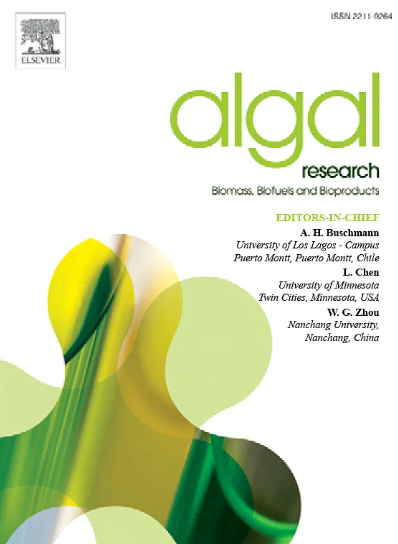Nutrient-driven biomass variation in Ulva prolifera: Experimental insights for predicting Yellow Sea green tide magnitude
IF 4.6
2区 生物学
Q1 BIOTECHNOLOGY & APPLIED MICROBIOLOGY
Algal Research-Biomass Biofuels and Bioproducts
Pub Date : 2025-06-16
DOI:10.1016/j.algal.2025.104143
引用次数: 0
Abstract
The green tide in the Yellow Sea, one of the largest globally, is primarily driven by the biomass of Ulva prolifera, which is influenced by seawater nutrient levels, particularly inorganic nitrogen and phosphorus. This study aimed to clarify the relationship between U. prolifera growth and seawater nitrogen and phosphorus concentrations. Experiments were conducted in the northern Jiangsu coastal waters using three nutrient concentration gradients (high, medium, and low) to assess their impact on U. prolifera biomass. Additionally, the proportional relationship between nutrient uptake by algal tissue and nutrient depletion from the water was analyzed. Results showed a significant positive correlation between nitrogen and phosphorus concentrations and U. prolifera growth, with Spearman's correlation coefficients exceeding 0.4 and p-values <0.05. Increased nitrogen and phosphorus levels promoted faster growth and higher biomass, with NH4+ having the most pronounced effect, leading to a maximum weight gain of 107.4 %. Nutrient uptake measurements indicated that for each gram of nitrogen absorbed, U. prolifera biomass increased by 277.9 g, and for each gram of phosphorus absorbed, biomass increased by 4056.5 g. In conclusion, nutrient enrichment accelerates U. prolifera growth, and limiting nitrogen and phosphorus inputs could reduce biomass accumulation in the early stages of green tide formation. These findings provide valuable insights for developing strategies to manage and control green tide events and protect marine ecosystems.
营养驱动的增生Ulva生物量变化:预测黄海绿潮幅度的实验见解
黄海的绿潮是全球最大的绿潮之一,主要是由藻的生物量驱动的,而藻的生物量受海水营养水平,特别是无机氮和磷的影响。本研究旨在阐明藻生长与海水氮、磷浓度的关系。采用高、中、低3种营养物浓度梯度,在苏北近岸海域进行了试验,探讨了营养物浓度梯度对藻生物量的影响。此外,还分析了藻类组织对养分的吸收与水体中养分的消耗之间的比例关系。结果表明,氮、磷浓度与浒苔生长呈显著正相关,Spearman相关系数大于0.4,p值为0.05。氮磷水平的提高促进了生长速度和生物量的提高,其中NH4+的影响最为显著,最大增重达107.4%。营养吸收测定结果表明,每吸收1克氮,藻体生物量增加277.9 g,每吸收1克磷,藻体生物量增加4056.5 g。综上所述,富营养化可加速藻体生长,限制氮磷输入可减少绿潮形成初期的生物量积累。这些发现为制定管理和控制绿潮事件和保护海洋生态系统的策略提供了有价值的见解。
本文章由计算机程序翻译,如有差异,请以英文原文为准。
求助全文
约1分钟内获得全文
求助全文
来源期刊

Algal Research-Biomass Biofuels and Bioproducts
BIOTECHNOLOGY & APPLIED MICROBIOLOGY-
CiteScore
9.40
自引率
7.80%
发文量
332
期刊介绍:
Algal Research is an international phycology journal covering all areas of emerging technologies in algae biology, biomass production, cultivation, harvesting, extraction, bioproducts, biorefinery, engineering, and econometrics. Algae is defined to include cyanobacteria, microalgae, and protists and symbionts of interest in biotechnology. The journal publishes original research and reviews for the following scope: algal biology, including but not exclusive to: phylogeny, biodiversity, molecular traits, metabolic regulation, and genetic engineering, algal cultivation, e.g. phototrophic systems, heterotrophic systems, and mixotrophic systems, algal harvesting and extraction systems, biotechnology to convert algal biomass and components into biofuels and bioproducts, e.g., nutraceuticals, pharmaceuticals, animal feed, plastics, etc. algal products and their economic assessment
 求助内容:
求助内容: 应助结果提醒方式:
应助结果提醒方式:


